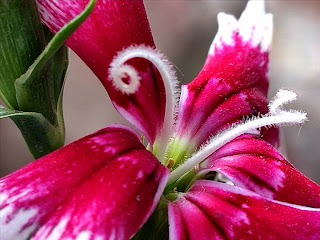Sweet Williams
Details of the photograph is here:-
This picture has been clicked on 11 February, 2021 by using the device Redmi K20 pro f/1.75 1/107 IOS112 4.77mm using a macro lens. Without using flash.
I know that you all are truly attracted by this beautiful and aesthetic pink and white flower. It is correct to make white colour as the symbol of peace because it really gives peace to all us. As we can see this white and pink flower gives a soothing feeling to us. These blooming flowers are as adorable as a cute and fluffy teddy. No doubt, this is a bouquet full of beauty.
Do you know the name of this double coloured flower?
It is "Sweet William". Yes, the name is so weird and interesting too. This is a white and pink sweet william flower. Sweet william are a beautiful, colourful biennial flower that will reseed itself. The plant grows for two years, blooming in the second year.
Sweet william mainly have five petals often with a frilled or zigzag edge, in hues of white or red tones that range from pale pink through to deep maroon. It is of double toned. It belongs from Dianthus Barbatus family. It have two nectar and a beautiful dual colour which makes it more attractive adorable.
Sweet william is also known as Dianthus chinensis. It is commonly known as China pink (Chinese: 石竹 shí zhú) or rainbow pink. It is a species os Dianthus natives to northern China, Mongolia, Korea and southeastern Russia. It is a herbaceous perennial plant.
Classification
Genus:Dianthus
Clade:Eudicots
Genus:Dianthus
Clade:Eudicots
Kingdom:Plantae
Clade:Angiosperms
Clade:Tracheophytes
Order:Caryophyllales
Family:Caryophyllaceae
Species: Dianthus chinensis
Binomial name: Dianthus chinensis
The plant of this pinkish white flower has a large distribution area in the East Asia, which includes not only China, but also Korea and eastern Russia, to the northwest it still occurs in Mongolia and Kazakhstan. It grows to 30–50 cm tall. The flower of China also counts Europe as the area of distribution. The sites include grasslands as well as sparse forests.
There are approximately 300 species of this sweet william flower. Of the 300 species, most are native to Europe and Asia, a few are indigenous to north Africa, and one alpine species is native to the arctic regions of North America.
There are many are herbaceous perennials, but there are some hardy annuals and biennials available, and even a few which are classified as dwarf shrubs.
They feature narrow, linear and small
leaves with a blue-green hue that appear opposite one another on narrow stems.
With a long bloom period from late spring untill early autumn, their attractive mounding growth and pretty flowers are complemented by a heady fragrance of spicy sweetness that is evocative of cinnamon and cloves.
Many sources contend that the flower was named for William Augustus, duke of Cumberland, who led British forces against the Jacobites at the Battle of Culloden in 1746. Other sources claim, however, that the name of the flower can be traced to the writings of Thomas Tusser, a 16th-century English poet. In Scotland the flower is known as stinking Willie or sour Billy.
This old-fashioned favorite from Europe is a short-lived perennial that produces clusters of fragrant flowers in shades of white, pink, purple, red and violet. Suitable for beds & borders, cut flowers, and the fragrant garden. Flowers attract butterflies , bees and many insects.
It is a symbol of bravery and superiority. Sweet William is a very special flower because it is one associated with vigour. The blooms remind me of a cluster of soldiers, sticking together, protecting each other and each fighting for a cause.
This cause is bringing a smile to the face of the recipient.
Sweet William plants thrive in full sun but they can tolerate light shade. Plant them in a spot where they receive sunlight for at least 4-5 hours in a day otherwise they will not grow healthier.
The plants prefer rich fertile, mildly alkaline of PH 6.75 and well-drained soil. So plant them in a rich fertile soil.
Some of the pests and insects that can infect Dianthus Sweet Williams include nematodes, slugs and grasshoppers. Aphids may also feed on the stems. But they can be easily controlled with a spray of water from a hose. So it is important to monitor them.
Ornamental plants bloom in clusters in spring and grow best in cottage beds, garden borders, and containers. The plant variety is easy to grow and maintain. However, they need to be replanted after one or two years as they do not survive for long. The flower produces nectar that attracts birds, bees, moths, and butterflies.
Sweet William seeds are tough enough to survive most winters, and can be planted in fall or late spring to bloom 12 to 18 months later. If the plants have already started growing, or if you are concerned about a harsh winter, you may keep the plants in indoor pots, then transplant them outdoors in early spring.
Divide sweet William every 2 to 4 years. Doing this in the spring just to as the season's new growth is starting is the best. But if you don't get to the plant before it flowers, wait and divide it in the fall. Avoid dividing plants that are in bloom or already stressed by insects, disease or other conditions.
So, this was the overview of a flower named Sweet William. Hoping this would be helpful to you.










No comments:
Post a Comment